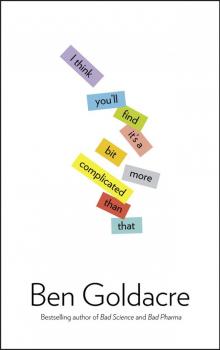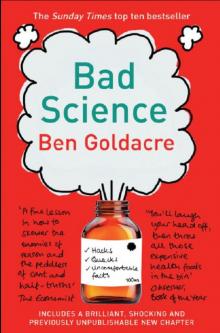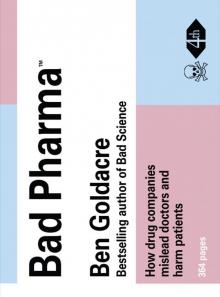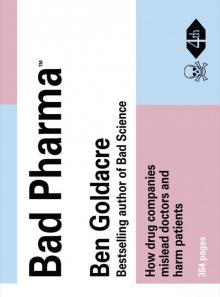- Home
- Ben Goldacre
Bad Science
Bad Science Read online
BEN GOLDACRE
Bad Pharma
How Drug Companies Mislead Doctors and Harm Patients
FOURTH ESTATE • London
DEDICATION
To whom it may concern
CONTENTS
Cover
Title Page
Dedication
Intro
1 Missing Data
2 Where Do New Drugs Come From?
3 Bad Regulators
4 Bad Trials
5 Bigger, Simpler Trials
6 Marketing
Afterword: Better Data
Glossary
Acknowledgements, Further Reading and a Note on Errors
Notes
About the Author
Copyright
About the Publisher
INTRO
Medicine is broken. And I genuinely believe that if patients and the public ever fully understand what has been done to them – what doctors, academics and regulators have permitted – they will be angry. On this, only you can judge.
We like to imagine that medicine is based on evidence, and the results of fair tests. In reality, those tests are often profoundly flawed. We like to imagine that doctors are familiar with the research literature, when in reality much of it is hidden from them by drug companies. We like to imagine that doctors are well-educated, when in reality much of their education is funded by industry. We like to imagine that regulators only let effective drugs onto the market, when in reality they approve hopeless drugs, with data on side effects casually withheld from doctors and patients.
I’m going to tell you how medicine works, just over the page, in one paragraph that will seem so absurd, so ludicrously appalling, that when you read it, you’ll probably assume I’m exaggerating. We’re going to see that the whole edifice of medicine is broken, because the evidence we use to make decisions is hopelessly and systematically distorted; and this is no small thing. Because in medicine, doctors and patients use abstract data to make decisions in the very real world of flesh and blood. If those decisions are misguided, they can result in death, and suffering, and pain.
This isn’t a simple story of cartoonish evil, and there will be no conspiracy theories. Drug companies are not withholding the secret to curing cancer, nor are they killing us all with vaccines. Those kinds of stories have, at best, a poetic truth: we all know, intuitively, from the fragments we’ve picked up, that something is wrong in medicine. But most of us, doctors included, don’t know exactly what.
These problems have been protected from public scrutiny because they’re too complex to capture in a soundbite, or even 3,000 words. This is why they’ve gone unfixed by politicians, at least to some extent; but it’s also why you’re holding a book of over four hundred pages. The people you should have been able to trust to fix these problems have failed you, and because you have to understand a problem properly in order to fix it yourself, this book contains all that you need to know.
So, to be clear, this whole book is about meticulously defending every assertion in the paragraph that follows.
Drugs are tested by the people who manufacture them, in poorly designed trials, on hopelessly small numbers of weird, unrepresentative patients, and analysed using techniques which are flawed by design, in such a way that they exaggerate the benefits of treatments. Unsurprisingly, these trials tend to produce results that favour the manufacturer. When trials throw up results that companies don’t like, they are perfectly entitled to hide them from doctors and patients, so we only ever see a distorted picture of any drug’s true effects. Regulators see most of the trial data, but only from early on in a drug’s life, and even then they don’t give this data to doctors or patients, or even to other parts of government. This distorted evidence is then communicated and applied in a distorted fashion. In their forty years of practice after leaving medical school, doctors hear about what works through ad hoc oral traditions, from sales reps, colleagues or journals. But those colleagues can be in the pay of drug companies – often undisclosed – and the journals are too. And so are the patient groups. And finally, academic papers, which everyone thinks of as objective, are often covertly planned and written by people who work directly for the companies, without disclosure. Sometimes whole academic journals are even owned outright by one drug company. Aside from all this, for several of the most important and enduring problems in medicine, we have no idea what the best treatment is, because it’s not in anyone’s financial interest to conduct any trials at all. These are ongoing problems, and although people have claimed to fix many of them, for the most part they have failed; so all these problems persist, but worse than ever, because now people can pretend that everything is fine after all.
That’s a lot to stand up, and the details are much more horrific than that paragraph makes it sound. There are some individual stories that will make you seriously question the integrity of the individuals involved; some that will make you angry; and some, I suspect, that might make you very sad. But I hope you will come to see that this is not just a book about bad people. In fact, it’s possible for good people, in perversely designed systems, to casually perpetrate acts of great harm on strangers, sometimes without ever realising it. The current regulations – for companies, doctors and researchers – create perverse incentives; and we’ll have better luck fixing those broken systems than we will ever have trying to rid the world of avarice.
Some people will say that this book is an attack on the pharmaceutical industry, and of course it is. But it’s not only that, and it’s not unbounded. I suspect that most of the people who work in this industry are fundamentally good-hearted, and there is no medicine without medicines. Drug companies around the world have produced some of the most amazing innovations of the past fifty years, saving lives on an epic scale. But that does not allow them to hide data, mislead doctors and harm patients.
Today, when an academic or doctor tells you that they are working for the pharmaceutical industry, they often do so with a look of quiet embarrassment. I want to work towards a world where doctors and academics can feel actively optimistic about collaborating with industry, to make better treatments and better patients. This will require big changes, and some of them have been a very long time coming.
To that end, because the stories I am telling you are so worrying, I’ve tried to go beyond simply documenting the problems. Where there are obvious fixes, I’ve set out what they are. But I’ve also included, at the end of each chapter, some suggestions on what you can do to improve things. These are tailored to whoever you might be: a doctor, a patient, a politician, a researcher, a regulator or a drug company.
More than anything, though, I don’t want you to lose sight of one thing: this is a pop science book. The tricks and distortions documented in these pages are beautiful, and intricate, and fascinating in their details. The true scale of this murderous disaster only fully reveals itself when the details are untangled. Good science has been perverted on an industrial scale, but this has happened slowly, and evolved naturally, over time. This has all been perpetrated by ordinary people, but many of them may not even know what they’ve done.
I want you to find them, and tell them.
What’s coming
The book follows a simple trajectory.
We start by defending our central claim: industry-sponsored studies are more likely to produce results that flatter the sponsor’s drug, which has now been demonstrated, beyond any doubt, by current research. In this section we also encounter the idea of a ‘systematic review’ for the first time. A systematic review is an unbiased survey of all the evidence on a given question. It is the best-quality evidence that can be used, and where they exist, systematic reviews are used for evidence throughout this book, with individual studies desc
ribed only to give you a flavour of how the research has been done, or how mischief has been made.
Then we look at how the pharmaceutical industry manages to create all these positive trials for its drugs. Our first stop is to review the evidence showing that unflattering trial data can simply be withheld from doctors and patients. Companies are perfectly entitled to conduct seven studies, but only publish the two positive ones, and this behaviour is commonplace. What’s more, it happens in every field of science and medicine: from basic laboratory research, where selective publication fills the literature with false positive findings, wasting everyone’s time; through early research trials, where evidence that drugs might be dangerous is hidden from view; and on to major trials used to inform everyday clinical practice. Because so much trial data is withheld from doctors and patients, we can have no clear idea of the true effects of the treatments that we use every day in medicine. The stories in this section go from antidepressants, through statins, cancer drugs, diet pills, and right up to Tamiflu. Governments around the world have spent billions of dollars to stockpile this flu drug, in fear of a pandemic, and yet the evidence on whether it reduces the rate of pneumonia and death is being withheld right now, to this day.
Next, we take a step back, to look at where drugs come from. We cover the drug development process, from the moment someone dreams up a new molecule, through tests in labs, on animals, the first tests in humans, and then the early trials necessary to show that a drug works on patients. Here you will find, I suspect, some surprises. Risky ‘first-in-man’ drug tests are conducted on homeless people; but more than that, full clinical trials are being globalised, a new development that has arisen very suddenly, in only the last couple of years. This raises serious ethical problems, because trial participants in developing countries are often unlikely to benefit from expensive new drugs; but it also raises interesting new problems for trusting the data.
Then we look at regulation, and the hoops you must go through to get a drug onto the market. We will see that the bar is very low: that drugs must only prove that they are better than nothing, even when there are highly effective treatments on the market already. This means that real patients are given dummy placebo pills for no good reason, but also that drugs appear on the market which are worse than the treatments we already have. We will see that companies break their promises over follow-up studies, and that regulators let them do this. We will also see how data on side effects and effectiveness can be withheld from regulators, and that regulators, in turn, are obsessively secretive, withholding the data they do have from doctors and patients. Lastly, we will see the harm done by this secrecy: ‘many eyes’ are often very powerful, to spot problems with medicines, and some of the most frightening harms have been missed by regulators, and only identified by academics who were forced to fight hard for access to data.
Then we take a tour through ‘bad trials’. It is tempting to believe that a simple clinical trial is always a fair test of a treatment: and if done properly, it is. But several tricks have been introduced, over the course of many years, which allow researchers to overstate and exaggerate the benefits of the treatments they are testing. When you get here, you might think that some of these are innocent mistakes; in all seriousness, while I doubt that, I’m more interested in how clever they are. More importantly, we will see how obvious these tricks are, and how people who should know better at every step of the chain, from ethics committees through to academic journals, have allowed companies and researchers to engage in these shameful, outright distortions.
After a brief detour to discuss how some of the problems around bad evidence, and missing evidence, could be addressed, we move on to marketing, which is where most previous books on drug companies have focused their attention.
Here we will see that pharmaceutical companies spend tens of billions of pounds every year trying to change the treatment decisions of doctors: in fact, they spend twice as much on marketing and advertising as they do on the research and development of new drugs. Since we all want doctors to prescribe medicine based on evidence, and evidence is universal, there is only one possible reason for such huge spends: to distort evidence-based practice. All of this money comes directly from patients and governments, so we ourselves are paying for this privilege. Doctors spend forty years practising medicine, with very little formal education after their initial training. Medicine changes completely in four decades, and as they try to keep up, doctors are bombarded with information: from adverts that misrepresent the benefits and risks of new medicines; from sales reps who spy on patients’ confidential prescribing records; from colleagues who are quietly paid by drug companies; from ‘teaching’ that is sponsored by industry; from independent ‘academic’ journal articles that are quietly written by drug company employees; and worse.
Finally, we will see what can be done. While the deceit of a marketing drive can be ignored by an ethical doctor, the problems caused by distorted evidence affect everybody, without exception. The most expensive doctors in the world can only make decisions about your care on the basis of the evidence publicly available to them, and nobody has a special inside track. If this evidence is distorted, then we are all exposed to avoidable suffering, pain and death. The whole system needs to be fixed, and until it is, we are all, very truly, in this together.
How to read this book
I deliberately haven’t gone overboard to explain every medical term, to save space and avoid distractions: this doesn’t mean that you miss out. If a symptom, for example, isn’t explained or defined, that means you genuinely don’t need this detail to understand the story; but I’ve left the long word in to help medics or academics find their feet, and to anchor the general principle in a specific corner of medicine for them. Acronyms and abbreviations are defined as we go, and used in a haphazard way after that, because this is how people talk in the real world. There’s a glossary at the back for some common ideas, really just in case you read sections out of order, but there’s nothing in there that doesn’t come up in the main text.
Similarly, I haven’t given the full names of most clinical trials, because they are conventionally known by their acronyms, and most medical textbooks wouldn’t bother either: the ‘ISIS trial’, the ‘CAST trial’, in the minds of most doctors and academics, are the real names. If you’re very interested, you can search for them online or in the endnotes, but they’re not relevant to your enjoyment or understanding of the arguments in this book. Drugs present a different problem, because they have two names: the generic name, which is the correct scientific name for the molecule; and then the brand name used by the company manufacturing it in their packaging and advertising, which is usually a bit catchier. In general, doctors and academics think you should always use the scientific name, because it tells you a little about the class of the molecule, and is less ambiguous; while journalists and patients will more often use brand names. But everybody is inconsistent about which name they use, and in this book, so am I. Again, this simply reflects how people talk about medicines in the real world.
All the specific studies discussed are referenced at the back of the book. Where there was a choice, I’ve tried to select papers in open-access journals, so that they can be read for free by all. I’ve also tried to reference papers that give a good overview of a field, or good books on a subject, so that you can read more on whole areas if you want to.
Lastly: to an extent, this is a field where you need to know everything, to understand how it impacts on everything else. I’ve bent over backwards to introduce the ideas in the best order, but if all this material is completely new to you, then you might spot some extra connections – or feel greater outrage in your belly – reading it a second time. I have not assumed any prior knowledge. I have, however, assumed that you might be willing to deploy a little intellectual horsepower here and there. Some of this stuff is hard. That’s precisely why these problems have been ignored, and that’s why I’ve had to explain it to you here, in thi
s book. If you want to catch people with their trousers down, you have to go into their home.
Enjoy.
Ben Goldacre
August 2012
1
Missing Data
Sponsors get the answer they want
Before we get going, we need to establish one thing beyond any doubt: industry-funded trials are more likely to produce a positive, flattering result than independently-funded trials. This is our core premise, and you’re about to read a very short chapter, because this is one of the most well-documented phenomena in the growing field of ‘research about research’. It has also become much easier to study in recent years, because the rules on declaring industry funding have become a little clearer.
We can begin with some recent work: in 2010, three researchers from Harvard and Toronto found all the trials looking at five major classes of drug – antidepressants, ulcer drugs and so on – then measured two key features: were they positive, and were they funded by industry?1 They found over five hundred trials in total: 85 per cent of the industry-funded studies were positive, but only 50 per cent of the government-funded trials were. That’s a very significant difference.
In 2007, researchers looked at every published trial that set out to explore the benefit of a statin.2 These are cholesterol-lowering drugs which reduce your risk of having a heart attack, they are prescribed in very large quantities, and they will loom large in this book. This study found 192 trials in total, either comparing one statin against another, or comparing a statin against a different kind of treatment. Once the researchers controlled for other factors (we’ll delve into what this means later), they found that industry-funded trials were twenty times more likely to give results favouring the test drug. Again, that’s a very big difference.

 I Think You'll Find It's a Bit More Complicated Than That
I Think You'll Find It's a Bit More Complicated Than That 2008 - Bad Science
2008 - Bad Science Bad Science
Bad Science Bad Pharma
Bad Pharma